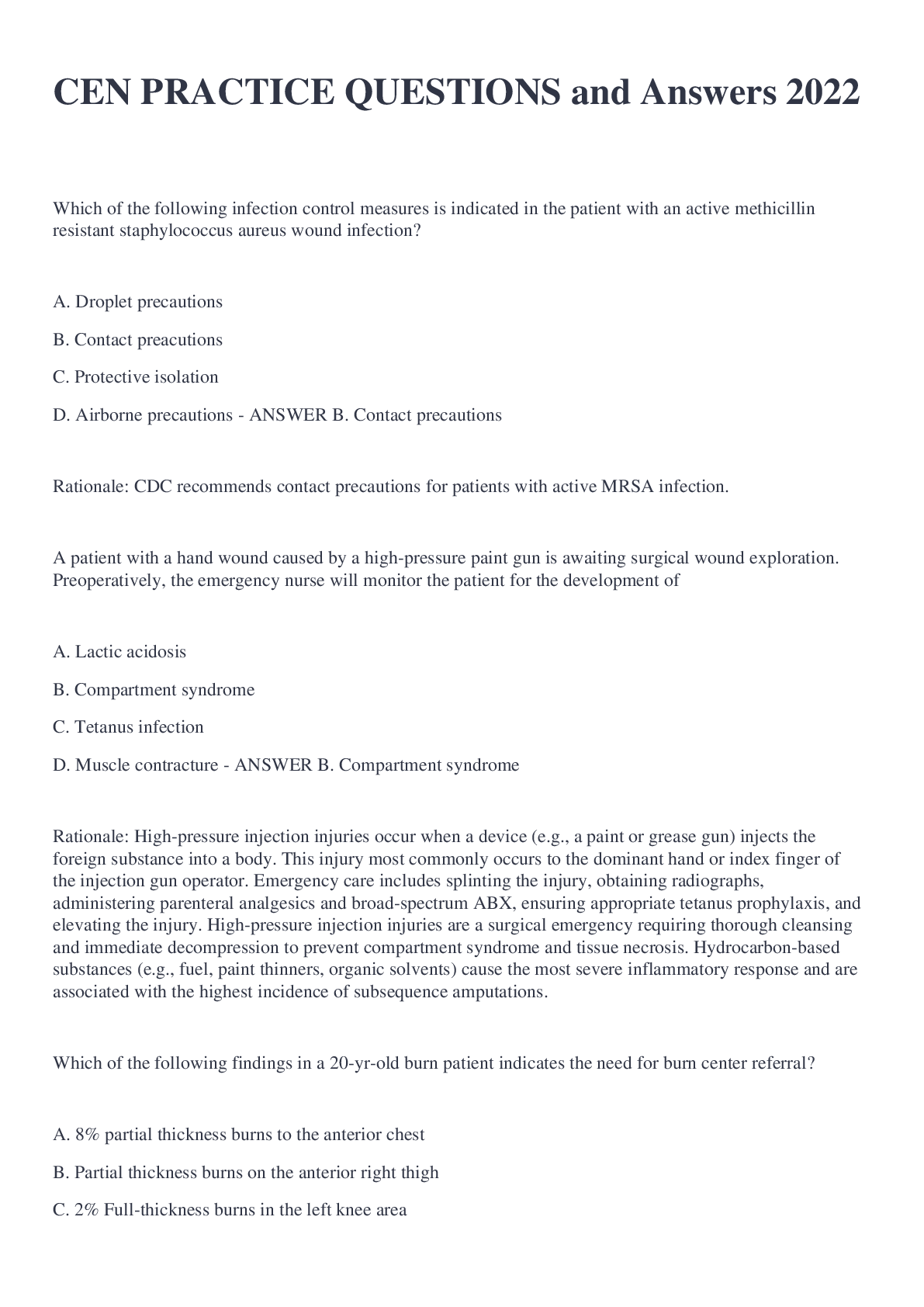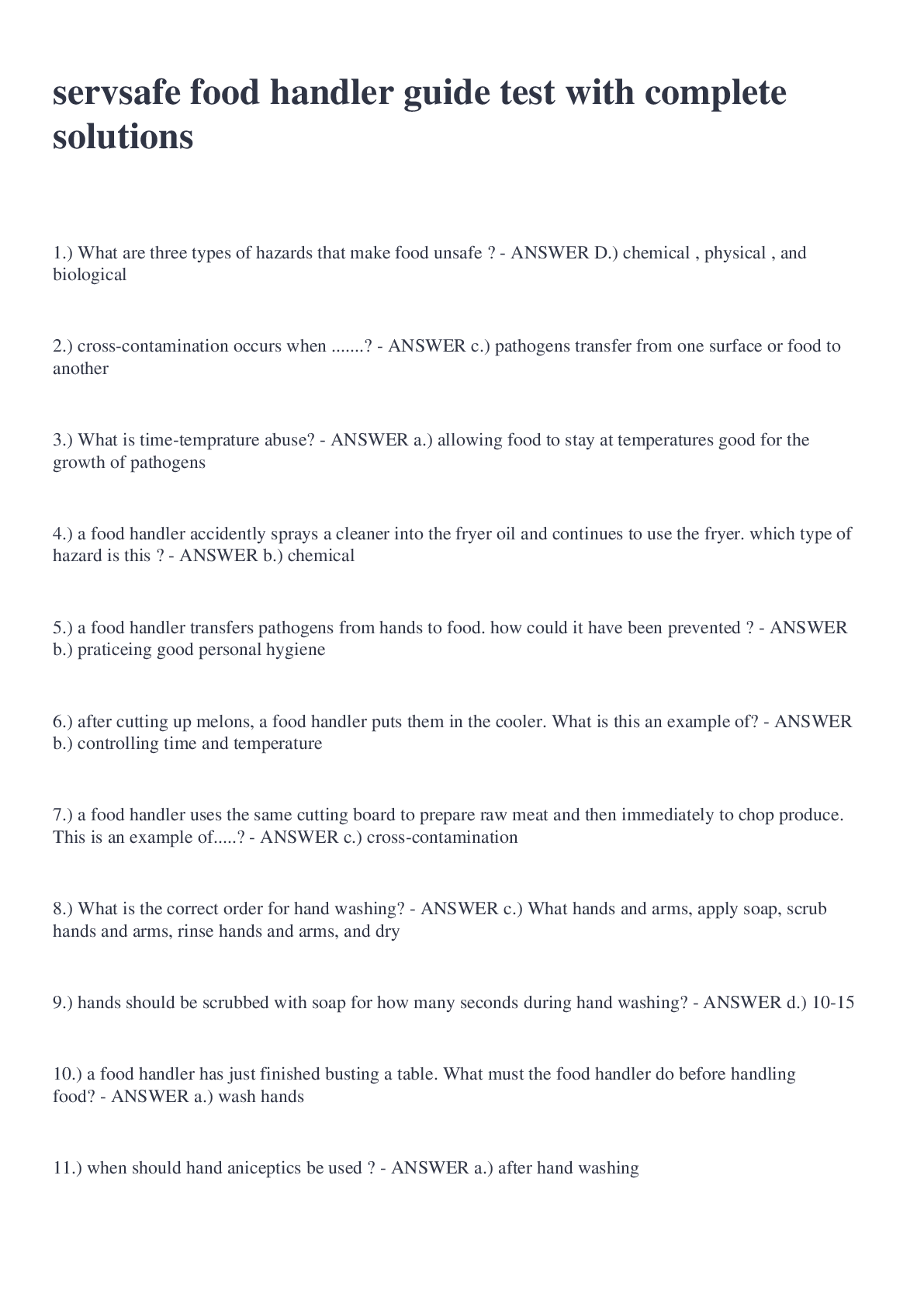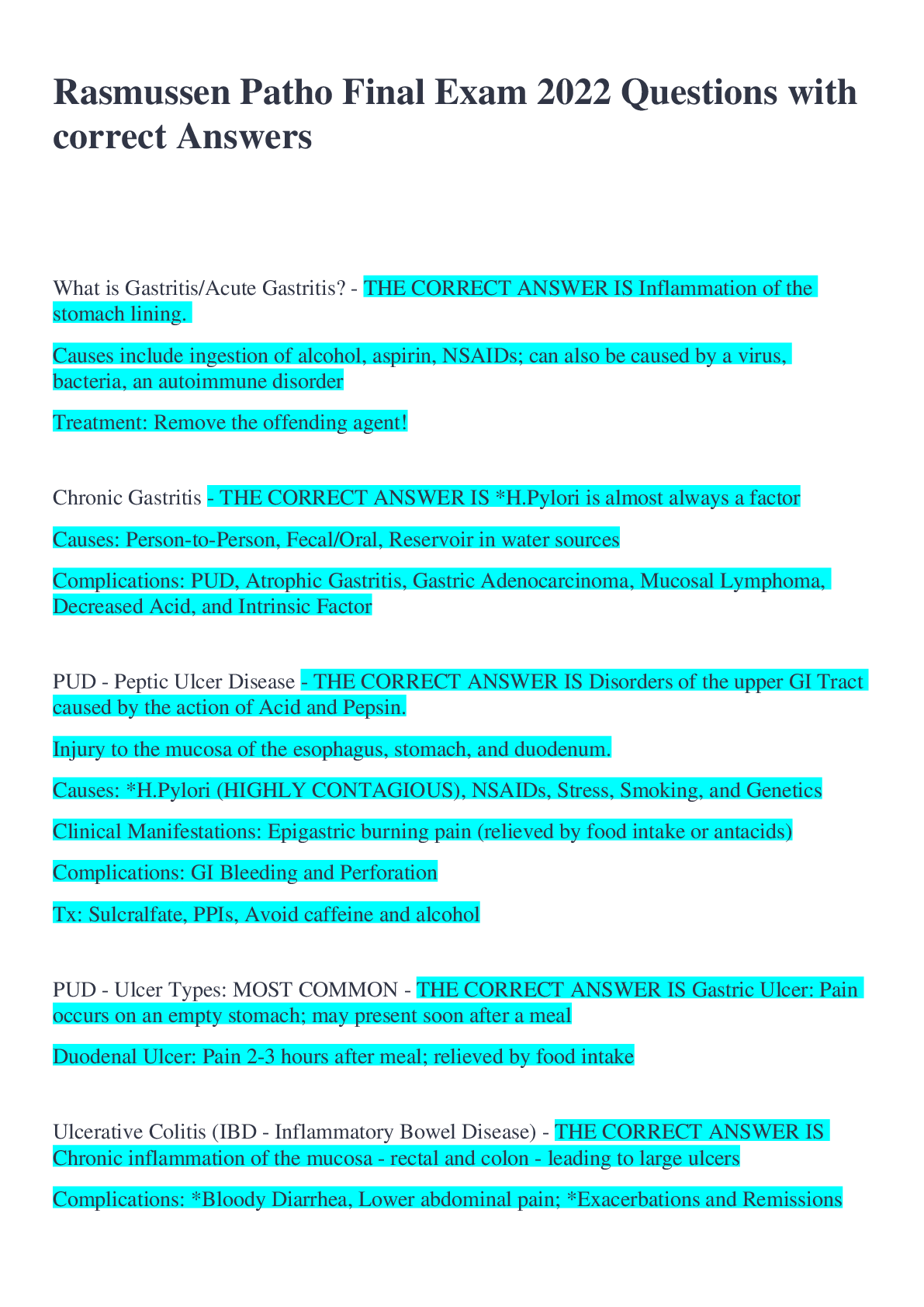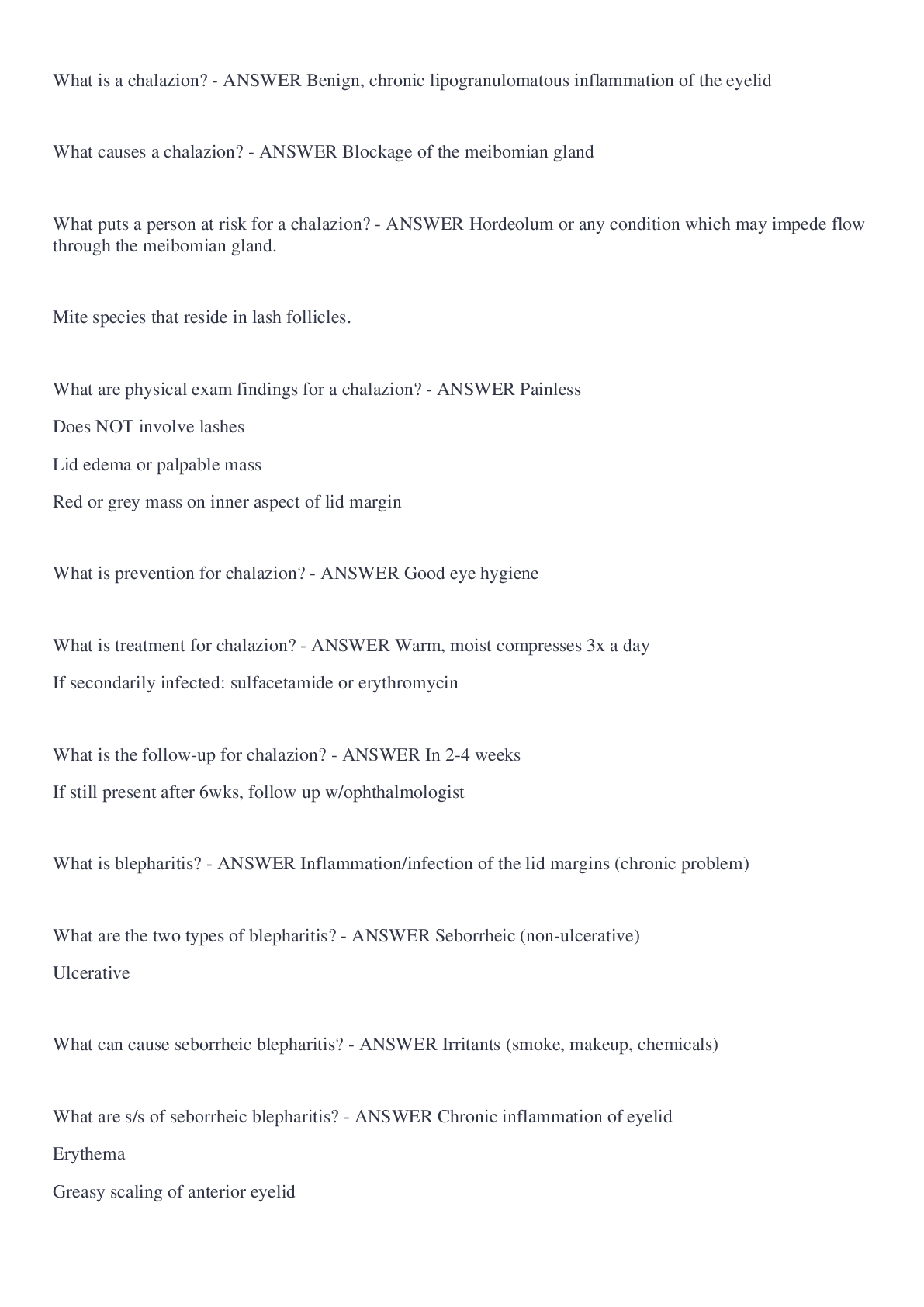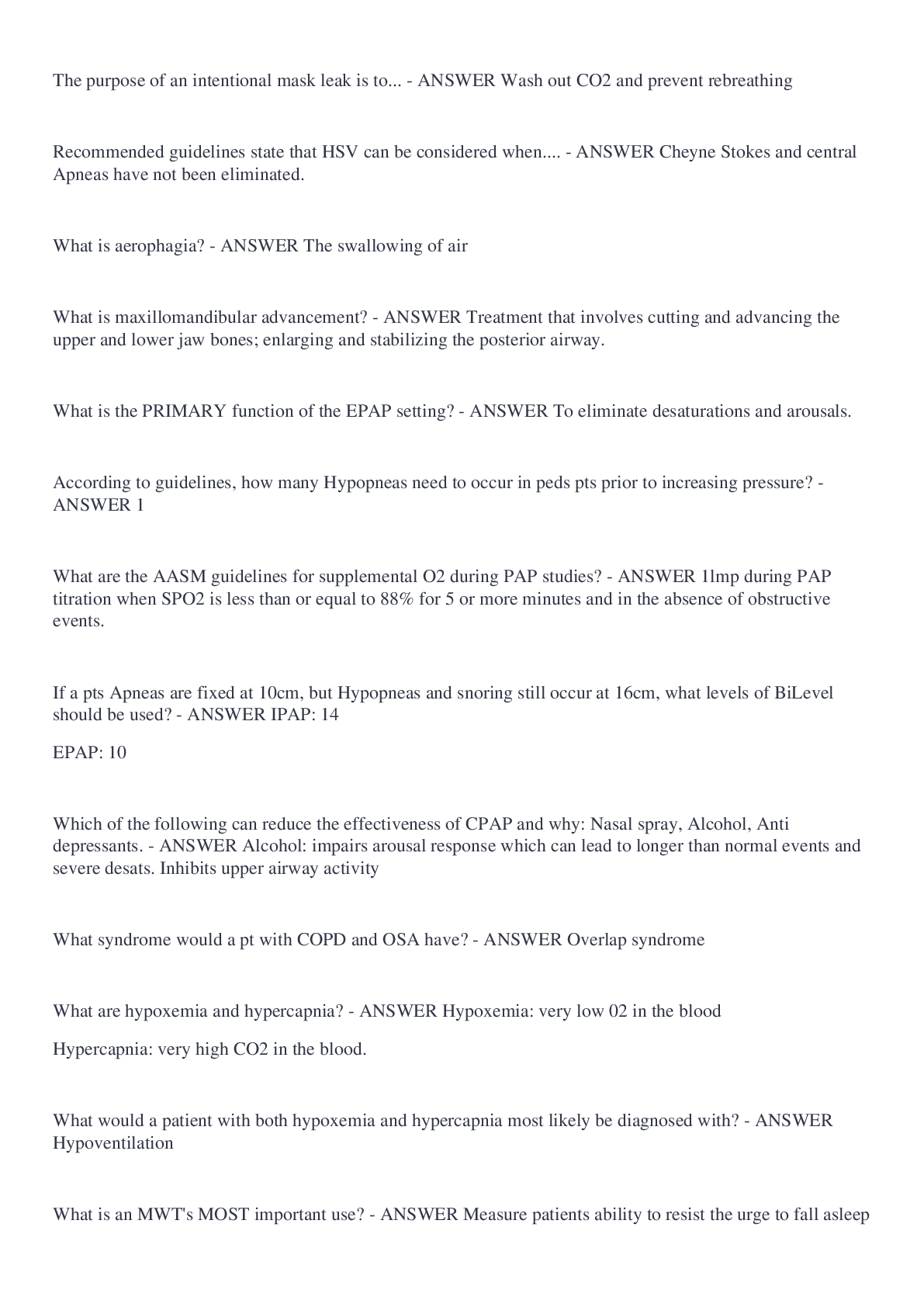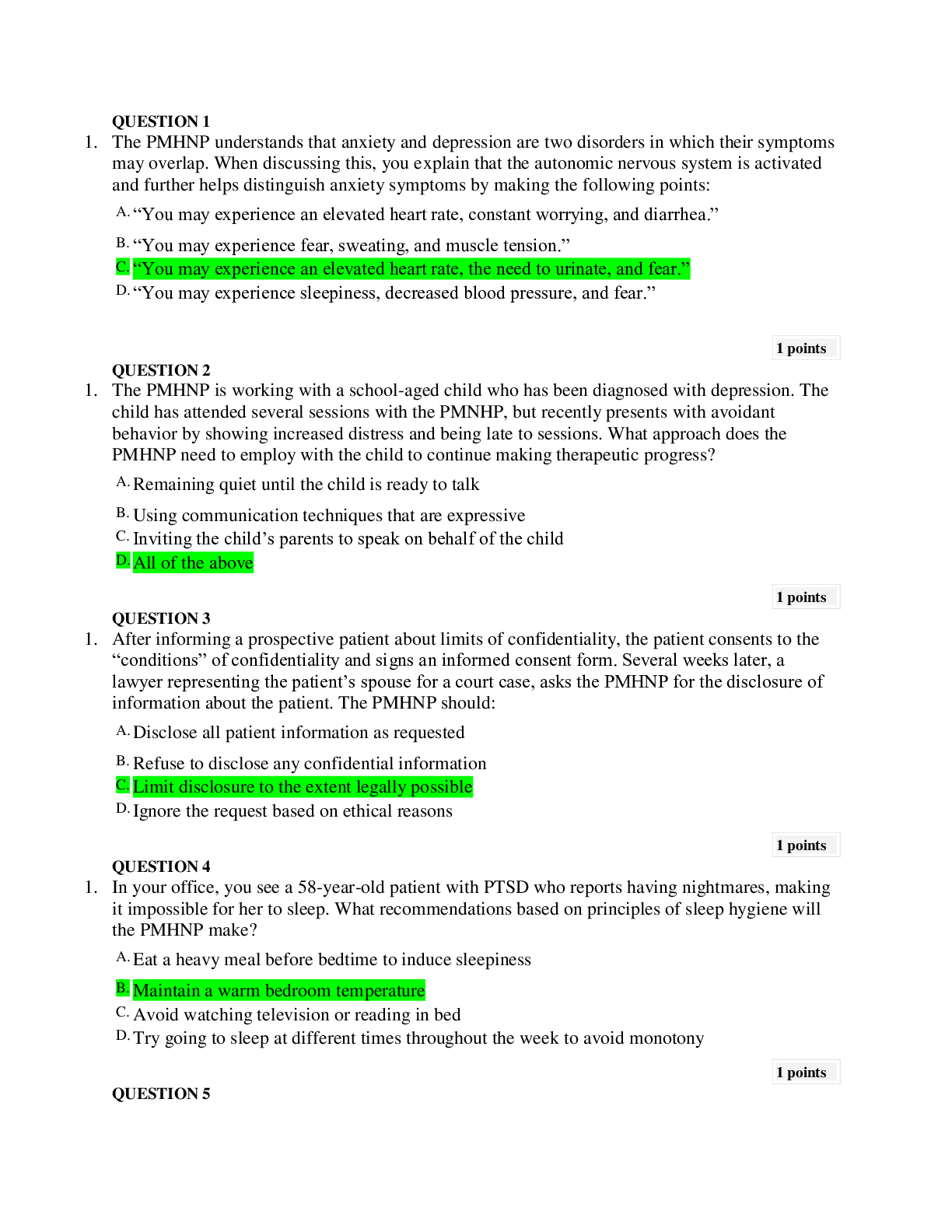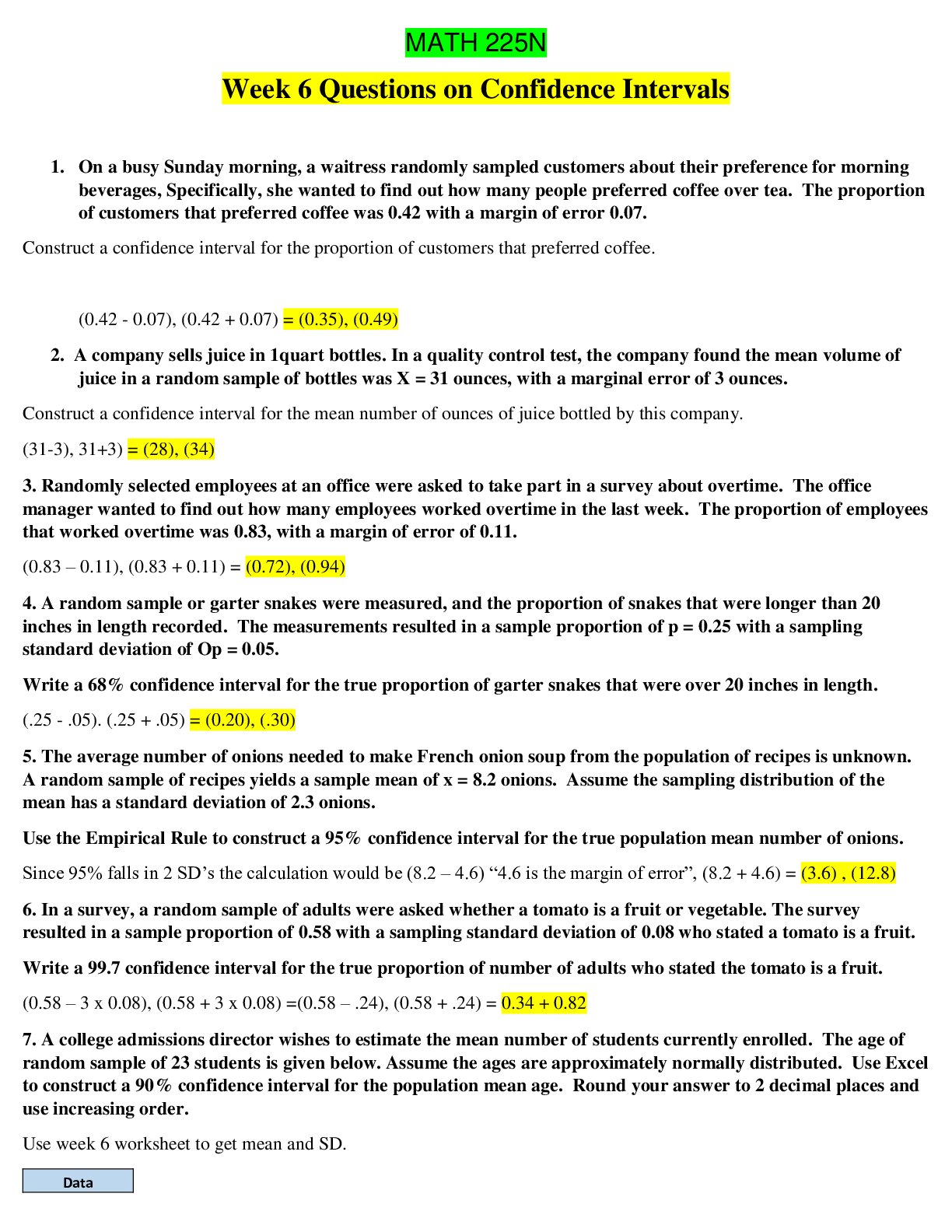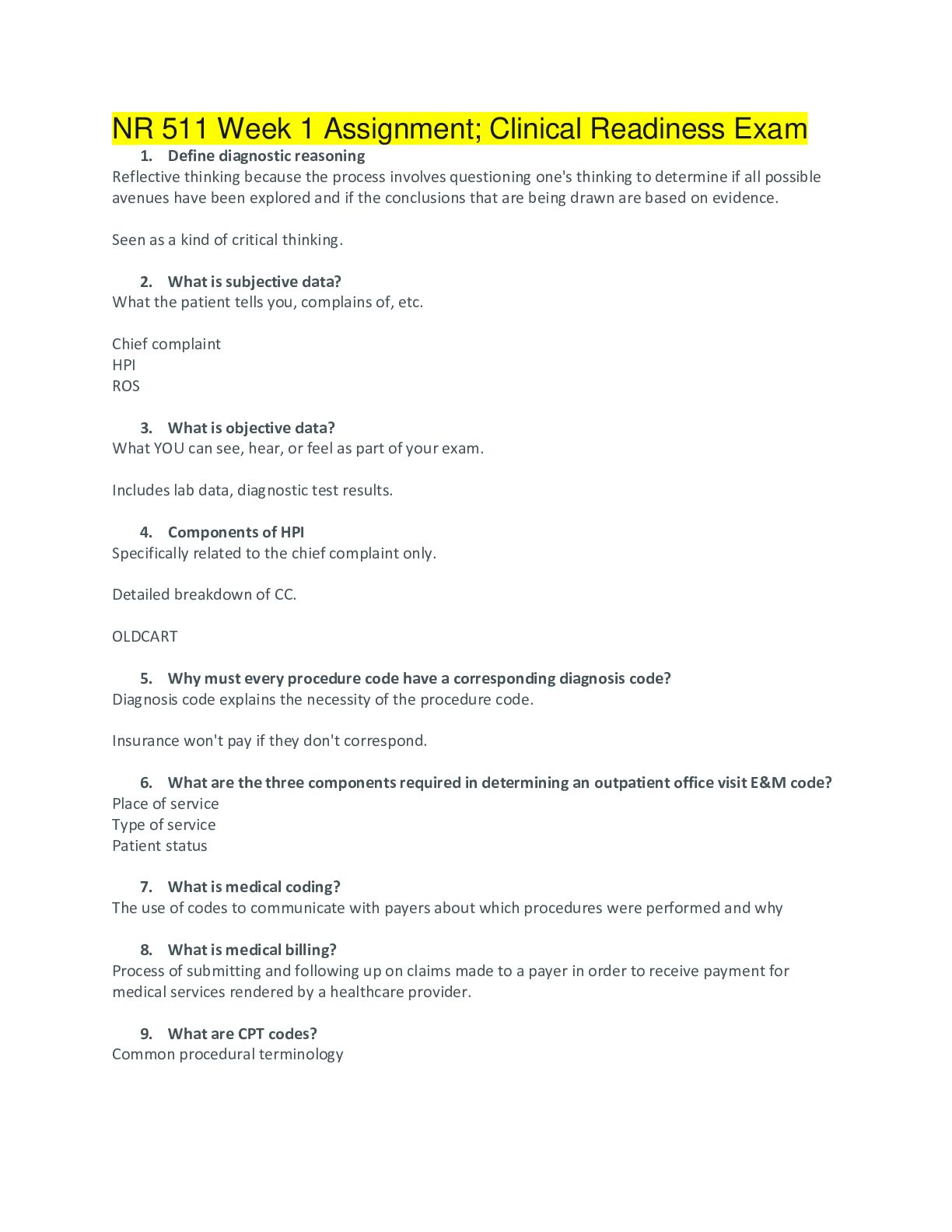NLN Pax RN Basic Chemistry Questions and Answers 2022/2023
Document Content and Description Below
MATTER Atomic Structure, Isotopes, Ions, and the Periodic Table - ANSWER a substance that has mass and occupies space. SUBSTANCE Atomic Structure, Isotopes, Ions, and the Periodic Table - ANS... WER matter that has the same composition and properties throughout ELEMENT Atomic Structure, Isotopes, Ions, and the Periodic Table - ANSWER any substance that cannot be broken down into simpler substances. Identified by its symbol and its atomic number. ATOMIC NUMBER Atomic Structure, Isotopes, Ions, and the Periodic Table - ANSWER is equal to the number of protons found in the nucleus. MASS NUMBER Atomic Structure, Isotopes, Ions, and the Periodic Table - ANSWER number of protons and neutrons (nucleons) in the nucleus of an atom ISOTOPE Atomic Structure, Isotopes, Ions, and the Periodic Table - ANSWER atoms of the same element with the same atomic number but with different numbers of neutrons ATOMIC MASS Atomic Structure, Isotopes, Ions, and the Periodic Table - ANSWER The atomic mass may be considered to be the total mass of protons, neutrons and electrons in a single atom. ION Atomic Structure, Isotopes, Ions, and the Periodic Table - ANSWER atom that has a positive or negative charge ATOM Atomic Structure, Isotopes, Ions, and the Periodic Table - ANSWER smallest unit of an element that still retains the properties of that element consists of thre subatomic particles. PROTON Atomic Structure, Isotopes, Ions, and the Periodic Table - ANSWER a subatomic particle that has a positive charge and that is found in the nucleus of an atom CATION Atomic Structure, Isotopes, Ions, and the Periodic Table - ANSWER a positively charged ion ANION Atomic Structure, Isotopes, Ions, and the Periodic Table - ANSWER a negatively charged ion VALENCE ELECTRON Atomic Structure, Isotopes, Ions, and the Periodic Table - ANSWER Electrons found on the outer shell of an atom which can combine with other atoms to form molecules PERIODIC TABLE Atomic Structure, Isotopes, Ions, and the Periodic Table - ANSWER A table that shows the elements, their atomic number, symbol, and average atomic mass; elements with similar chemical properties are grouped together. PERIOD Atomic Structure, Isotopes, Ions, and the Periodic Table - ANSWER a horizontal row of elements in the periodic table GROUP Atomic Structure, Isotopes, Ions, and the Periodic Table - ANSWER Vertical column of elements in the periodic table, Contains elements with similar properties because of their simlar electron configurations. NEUTRON Atomic Structure, Isotopes, Ions, and the Periodic Table - ANSWER subatomic particle with no charge and a mass about equal to a proton and found in the nucleus ELECTRON Atomic Structure, Isotopes, Ions, and the Periodic Table - ANSWER negatively charged particle and are found outside the nucleus and arranged according to their energy level METAL Atomic Structure, Isotopes, Ions, and the Periodic Table - ANSWER a chemical element that is a good conductor of both electricity and heat and forms cations and ionic bonds with non-metals. Found on the left side of the periodic table. ex. gold METALLOID Atomic Structure, Isotopes, Ions, and the Periodic Table - ANSWER an element that has some of the characteristics of metals and some characteristics of nonmetals, and are semiconductors, located in between the groups of metals and non-metals on the periodic table. ex. arsenic NONMETAL Atomic Structure, Isotopes, Ions, and the Periodic Table - ANSWER -an element that is a poor conductor of heat and electricity -poor conductors of heat and electricity when compared to metals -usually have lower densities than metals non-metals have high electronegativity ex. phosphorus NOBLE GASES Atomic Structure, Isotopes, Ions, and the Periodic Table - ANSWER Have full valence shells and are inert. The last group on the right of the periodic table. RADIO-ISOTOPE Atomic Structure, Isotopes, Ions, and the Periodic Table - ANSWER An isotope that has an unstable nucleus and undergoes radioactive decay OCTET RULE bonding - ANSWER States that atoms lose, gain or share electrons in order to acquire a full set of eight valence electrons IONIC BOND bonding - ANSWER a chemical bond in which one atom loses an electron to form a positive ion and the other atom gains to electron to form a negative ion LEWIS ELECTRON DOT DIAGRAM bonding - ANSWER the representation of an atom, ion or molecule, in which the element symbols stand for the nucleus and all inner level electrons while dots stand for outer level electrons COVALENT BOND bonding - ANSWER a chemical bond that involves sharing a pair of electrons between atoms in a molecule NONPOLAR COVALENT BOND bonding - ANSWER when two identical non-metals equally share electrons between them. One well known exception to the identical atom rule is the combination of carbon and hydrogen in all organic compounds. POLAR COVALENT BOND bonding - ANSWER the pair of electrons is shared however one atom has those electrons more than the other one does. An "unequal sharing." DIPOLE bonding - ANSWER Is a polar covalent bond where the distribution of charges is unequal so that the molecule has a positive and negative end. they have a higher melting and boiling point. ELEMENT elements, compounds, and states of matter - ANSWER any substance that cannot be broken down into simpler substances COMPOUND elements, compounds, and states of matter - ANSWER is a substance of two or more different atoms bonded together, which can be broken down into elements. GAS elements, compounds, and states of matter - ANSWER A state of matter with no definite shape or volume. Attractions between the atoms or molecules are weak, and the particles move around in a random and erratic manner. LIQUID elements, compounds, and states of matter - ANSWER A state of matter where there is no definite shape, and does not vary in volume. SOLID elements, compounds, and states of matter - ANSWER a form of matter that has a definite shape and volume, and its particles have very little movement. MELTING elements, compounds, and states of matter - ANSWER the process where heat changes something from a solid to a liquid EVAPORATION elements, compounds, and states of matter - ANSWER the process by which a liquid turns into a gas. VAPOR PRESSURE elements, compounds, and states of matter - ANSWER a measure of the force exerted by a gas above a liquid in a sealed container, which is specific for each liquid and at each temperature. CONDENSATION elements, compounds, and states of matter - ANSWER change of matter from a gas to a liquid state FREEZING elements, compounds, and states of matter - ANSWER the withdrawal of heat to change something from a liquid to a solid SUBLIMATION elements, compounds, and states of matter - ANSWER the change of a substance from a solid to a gas, without a liquid phase. Ex. dry ice HOMOGENEOUS MIXTURE mixtures, solutions, tinctures, and emulsions - ANSWER a mixture in which the composition is uniform throughout, so there will be no variation found within the sample. SOLUTION mixtures, solutions, tinctures, and emulsions - ANSWER a homogeneous mixture of two or more substances uniformly dispersed throughout, ex. sugar water, each sample of the water should contain an equal amount of dissolved sugar FILTRATION mixtures, solutions, tinctures, and emulsions - ANSWER a process that separates a solid from the liquid or gas in a heterogeneous mixture, by means of a filter. SOLVENT mixtures, solutions, tinctures, and emulsions - ANSWER a liquid substance capable of dissolving other substances SOLUTE mixtures, solutions, tinctures, and emulsions - ANSWER the dissolved substance in a solution TINCTURE mixtures, solutions, tinctures, and emulsions - ANSWER A solution where the solvent is alcohol. CHROMATOGRAPHY mixtures, solutions, tinctures, and emulsions - ANSWER the process of seperating a chemical mixture into its individual substances, aka Any of various techniques for the separation of complex mixtures that rely on the differential affinities of substances for a gas or liquid mobile medium and for a stationary adsorbing medium through which they pass, such as paper, gelatin, or magnesia. HETEROGENEOUS MIXTURE mixtures, solutions, tinctures, and emulsions - ANSWER composition may vary within a sample, particles may be able to be visibly seen. EMULSION mixtures, solutions, tinctures, and emulsions - ANSWER A suspension of small globules of one liquid in a second liquid with which the first will not mix SOLUBILITY mixtures, solutions, tinctures, and emulsions - ANSWER the ability of one substance to dissolve in another at a given temperature and pressure DISTILLATION mixtures, solutions, tinctures, and emulsions - ANSWER the process of purifying a liquid by boiling it and condensing its vapors CHEMICAL CHANGE chemical versus physical changes - ANSWER a type of change where a substance changes into a new and different substance iron exposed to oxygen makes iron oxide. PHYSICAL CHANGE chemical versus physical changes - ANSWER change a change from one state (solid or liquid or gas) to another without a change in chemical composition. Ice cubes that melt into liquid, both are the same substance, water but just in different forms. REACTION chemical versus physical changes - ANSWER process that leads to the transformation of one set of chemical substances to another. REACTANT chemical versus physical changes - ANSWER a chemical substance that is present at the start of a chemical reaction PRODUCT chemical versus physical changes - ANSWER a chemical substance formed as a result of a chemical reaction, but nothing was created or destroyed. SYNTHESIS (COMBINATION) REACTIONS chemical versus physical changes - ANSWER a chemical reaction in which two or more simple substances combine to form a new, more complex substance SINGLE REPLACEMENT REACTIONS chemical versus physical changes - ANSWER involves an element reacting with a compound. During this reaction, and atom of the single element replaces and element in the compound. DOUBLE DISPLACEMENT REACTIONS chemical versus physical changes - ANSWER displacement reactions where two ionic compounds react to form two new compounds, Happens a lot with acid-base reactions. ACID BASE REACTION chemical versus physical changes - ANSWER When an acid and base mix together, neutralize one another's properties, and the products are salt and water. NEUTRALIZATION REACTION chemical versus physical changes - ANSWER is a chemical reaction whereby an acid and a base react to form a salt. ACID chemical versus physical changes - ANSWER Conduct electricity Change blue litmus to red Have a sour taste React with bases to neutralize their properties React with active metals to liberate hydrogen ions BASE chemical versus physical changes - ANSWER Conduct electricity Change red litmus to blue Have a slippery feeling React with acids to neutralize their properties. Donates hydroxide ions. pH SCALE chemical versus physical changes - ANSWER scale a range of numbers used to describe how acidic or basic a solution is; ranges from 0 (most acidic) to 14 (most basic) INDICATOR chemical versus physical changes - ANSWER Acid base indicator such as litmus is a substance that changes color in an acid or base DECOMPOSITION REACTIONS chemical versus physical changes - ANSWER one reactant that is broken down into two or more simpler products. Heat is often used to drive this type of reaction. Ex. Heated carbonic acid decomposes into water and carbon dioxide. ACTIVATION ENERGY reaction rates and catalysis - ANSWER energy needed to get a reaction started CATALYST reaction rates and catalysis - ANSWER a substance that initiates or accelerates a chemical reaction, by lowering the activation energy needed. They affect the rate, and do not get used up EXOTHERMIC reaction rates and catalysis - ANSWER chemical reaction in which energy is primarily given off in the form of heat, products contain less energy than its reactants. ENDOTHERMIC reaction rates and catalysis - ANSWER describes a reaction that absorbs energy from the surroundings, its products contain more energy than its reactants. EQUILIBRIUM reaction rates and catalysis - ANSWER When molecules are moving form greater to lesser concentration in an attempt to reach a balanced state or in terms or chemical reactions the rate of the forward reaction is equal to the rate of the reverse reaction. ORGANIC COMPOUND organic chemistry - ANSWER compound that contains carbon, excluding carbonates and oxides HYDROCARBON organic chemistry - ANSWER organic molecule composed of only carbon and hydrogen atoms ALCOHOL organic chemistry - ANSWER A substituted hydrocarbon that contains one or more hydroxyl groups(-OH), such as methanol, or ethanol ALDEHYDE organic chemistry - ANSWER An organic molecule with a carbonyl group with at least one hydrogen attached to it, located at the end of the carbon skeleton. KETONE organic chemistry - ANSWER A compound containing a carbonyl group with two hydrocarbon groups attached to it STRUCTURAL FORMULA organic chemistry - ANSWER used to represent organic compounds, similar to lewis diagrams, but use a dash in place of a colon to represent a bond. CARBOHYDRATE organic chemistry - ANSWER contains carbon, hydrogen, and oxygen, and the ratio of hydrogen to oxygen is typically 2:1. The name carbohydrate means "watered carbon" or carbon with attached water molecules. MONOSACCHARIDES organic chemistry - ANSWER single sugar molecule (monomer) DISACCHARIDES organic chemistry - ANSWER A double sugar, consisting of two monosaccharides joined by dehydration synthesis. POLYSACCHARIDES organic chemistry - ANSWER a complex molecule composed of three or more monosaccharides (sugar) STARCH organic chemistry - ANSWER polysaccharide made up of a chain of glucose molecules; food storage molecule for plants GLYCOGEN organic chemistry - ANSWER Polysaccharide that is found in animals. LIPID organic chemistry - ANSWER macromolecule made mainly from carbon and hydrogen and oxygen atoms; includes fats, oils, and waxes, steroids. The molecules of such a lipid are made up of a glycerol molecule with three fatty acid molecules attached to it. FATTY ACID organic chemistry - ANSWER Fatty acids are made up of a long-chain carbon skeleton that has a carboxylic acid functional group. GLYCEROL organic chemistry - ANSWER Glycerol has a carbon skeleton of three carbon atoms with three alcohol groups attached to the carbons. At room temperature is has the appearance of a clear lightweight oil and is commonly used under the name glycerin PROTEIN organic chemistry - ANSWER an organic compound that is made of one or more chains of amino acids and that is a principal component of all cells Common test for presence of proteins is the Biuret Solution AMINO ACID organic chemistry - ANSWER are organic compounds which contain both an amino group and a carboxyl group. DEHYDRATION SYNTHESIS organic chemistry - ANSWER synthesis a chemical reaction in which large molecules are formed by removing water from smaller molecules and joining them together hydrolysis organic chemistry - ANSWER a chemical process in which a compound is broken down and changed into other compounds by taking up the elements of water Lugol's organic chemistry - ANSWER solution used to test for starch (iodine) Benedict's organic chemistry - ANSWER solution solution to test for glucose. [Show More]
Last updated: 1 year ago
Preview 1 out of 14 pages
Instant download
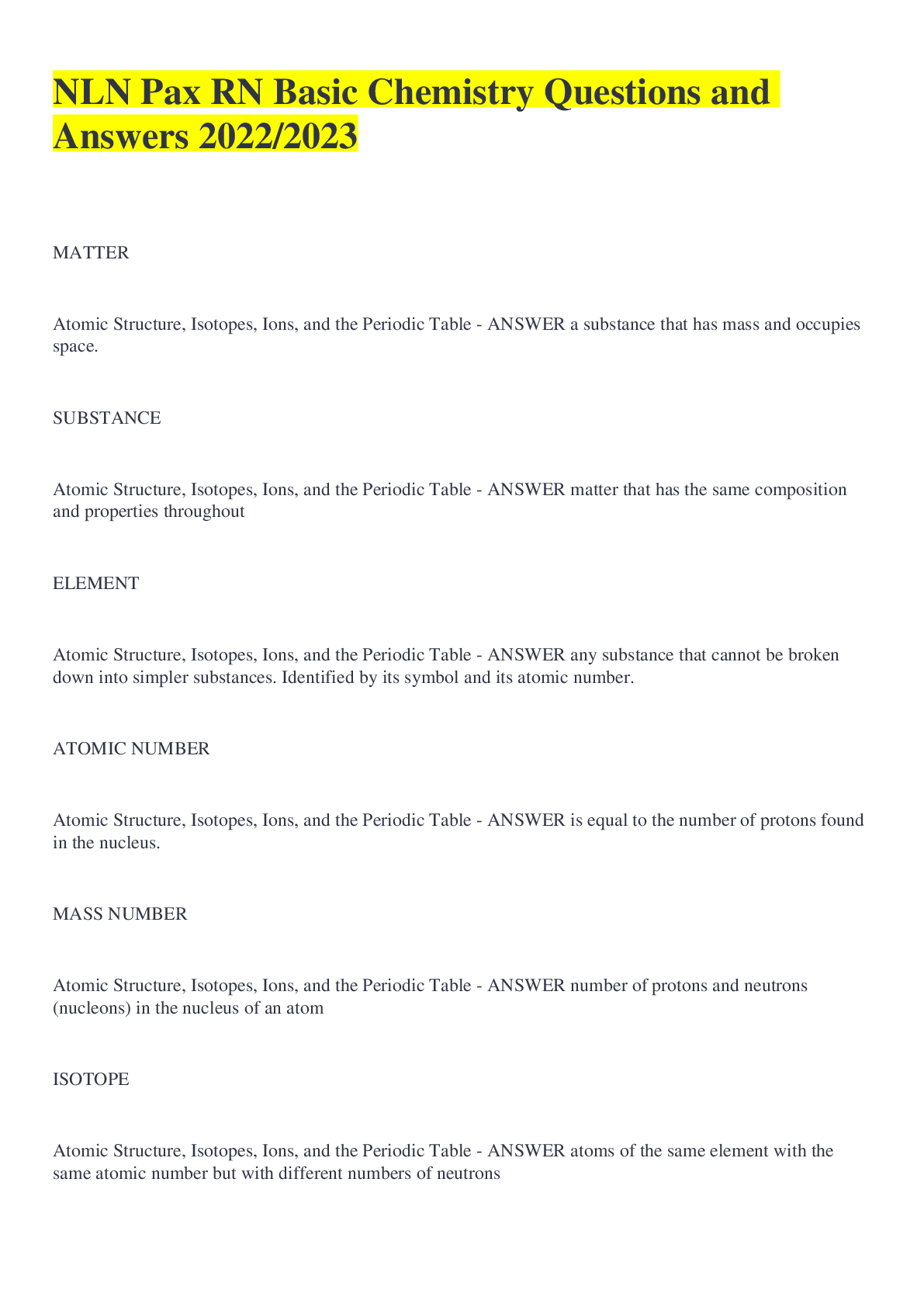
Buy this document to get the full access instantly
Instant Download Access after purchase
Add to cartInstant download
Reviews( 0 )
Document information
Connected school, study & course
About the document
Uploaded On
Sep 01, 2022
Number of pages
14
Written in
Additional information
This document has been written for:
Uploaded
Sep 01, 2022
Downloads
0
Views
69

